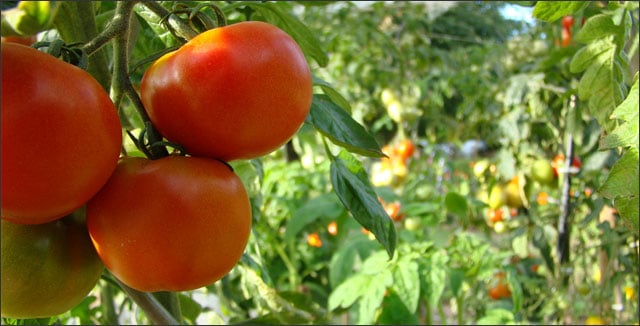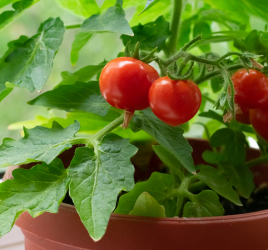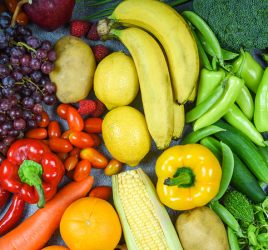
How to Create a Small Vegetable Garden With a Huge Impact

The book, Animal, Vegetable, Miracle by Barbara Kingsolver, is inspiring for anyone who has ever considered a vegetable garden.
Kingsolver recounts how she, her husband, and their two daughters moved from Arizona where growing your own food is much more difficult and uses up much precious water. The family settled in Virginia on a family property in order to grow their whole food supply.
Their goal was to grow and raise as much food as they could, in the form of garden vegetables and animals raised for meat. In addition, their goal to get everything else, like grains, as locally as possible.
What is most surprising and inspiring is the small amount of space the Kingsolvers used to accomplish this task. They had about ½ an acre of land for gardening and raising animals.
With such a small amount of space, one wonders how you might plant vegetables that yield the high amounts needed to sustain a family of four for a whole year.
It’s more doable than you think!
With a few tricks, you could get your small yard to yield many more vegetables this year.
Tips on Increasing the Yield of Your Small Vegetable Garden
Tip #1 – Build Raised Beds

Raised garden bed
There are some huge benefits to raised beds. First of all, they save space by being wherever you want them to be. No more encroaching grass in your garden plots!
The looser soil and higher content of organic matter on top of the ground soil make for much sweeter, juicier, and healthier plants when you come to harvest them.
In addition, weeding goes much faster as plants are closer together to discourage plants. Watering is more efficient, and access isn’t as much of a problem as it can be with traditional garden plots.
Raised beds also can be “heated” to extend their usefulness, as the soil above ground will get warmer faster in the season if treated properly. Raised beds drain better than ground soil, giving plants that extra edge. By slightly mounding the soil inside your raised bed, you can get another foot of growing space stretched along the top.
How to Build a Raised Bed for Your Garden
There are many good methods for building a raised bed. Untreated lumber and nails, or rebar make up many of the raised beds out there.
However, you can use sandbags or cinder blocks to form a barrier as well. You could use rocks, logs, or the wattle and daub method too. Really, any material that will hold in the soil will make a good raised bed.
You or your friends, neighbors or family members might have what you need lying around. Just make sure there aren’t chemicals in what you use that will leach into the soil.
Tip #2 – Pre-treat Your Soil
You want to remove any grass inside the bed and fill with organic, compost-rich soil. In the early months of spring, before planting can begin you can “heat” the soil by covering it with black plastic or infrared transmitting mulch.
Plant seedlings started inside after a month and cover with a clear plastic to keep the air around them warm – 65-75 degrees. You can remove these when the weather warms up and all frost has passed.
In the same way, you can stretch your growing season into the cooler months of fall. Just replace the plastic covering as frost and cool weather return.
Tip #3 – Make Plantings Closer
Weeding can be cut down to an absolute minimum just by planting your plants closer together in order to shade the ground around them and prevent weeds. Don’t plant in a square or rectangular pattern. Instead, use a triangular pattern to utilize the most space possible.
Of course, some plants do require more space and won’t do well planted too close to each other – the yield will go down. Make sure to do some research before you crowd anything.
Tip #4 – Companion Planting
Companion planting is the best way to get these high yields from small spaces. We can take our cues from the Native American “three sisters” planting: corn, beans, and squash.
It makes perfect sense. The corn grows fast, and upward, followed by beans, that can climb the corn stalks, and then squash is left to stretch out along the ground and shade it from weeds.
Other companion plantings that work well:
- tomatoes, basil, and onions
- leaf lettuce and peas or brassicas (cauliflower, cabbage, garden cress, bok choy, broccoli, Brussels sprouts, and similar green leaf vegetables)
- carrots, onions, and radishes
- beets and celery
Tip #5 – Make the Most of Your Vertical Space

Beans growing on poles
There are many plants that actually do better when left to climb. It is possible to grow many things vertically that don’t naturally grow that way. You can stick to frames or fences for things that naturally want to climb: tomatoes, pole beans, squash, melons, cucumbers, zucchini – the list goes on and on.
Creating a frame for climbing plants means they won’t hog much-need ground space in your small garden. If you have a sturdy fence surrounding your garden plot, like we do, maybe consider planting some of the climbing plants around the outside.
The great thing about melons, squash, and cucumbers is that you don’t have to worry that the vegetables – or fruits – themselves won’t be supported. Climbers grow thicker stems to support the weight of the fruit. Yes, even watermelons.
Growing climbing plants vertically saves time in harvesting, as you can see where the fruits are and it can literally save the plants from the fungal diseases they are prone to when lying on the ground.
Tip #6 – Multiple Growing Seasons
If you are a gardener, you are no stranger to overlapping growing seasons or multiple plantings on the same plot.
By starting your seeds inside and transplanting when conditions are perfect, rather than growing your garden from seeds in the ground, you can increase your garden’s yield.
Choose fast-maturing varieties, stretch your season by heating your soil, and you can get three different crops from a single plot in the space of one season. For instance, an early lettuce in spring, followed by a fast-growing corn in summer, and then a “winter” crop like turnips, beets or garlic in late summer or early fall.
Conclusion
It is possible to grow half a ton of your own, delicious and organically grown vegetables from a 15-by-20-foot plot. You can get 100 pounds of tomatoes from just 100 square feet (a 4-by-25-foot bed), or 20 pounds of carrots from just 24 square feet.
Does that change your mind about growing your own food? I hope it inspires you to grow your own beautiful and healthy organic garden.



